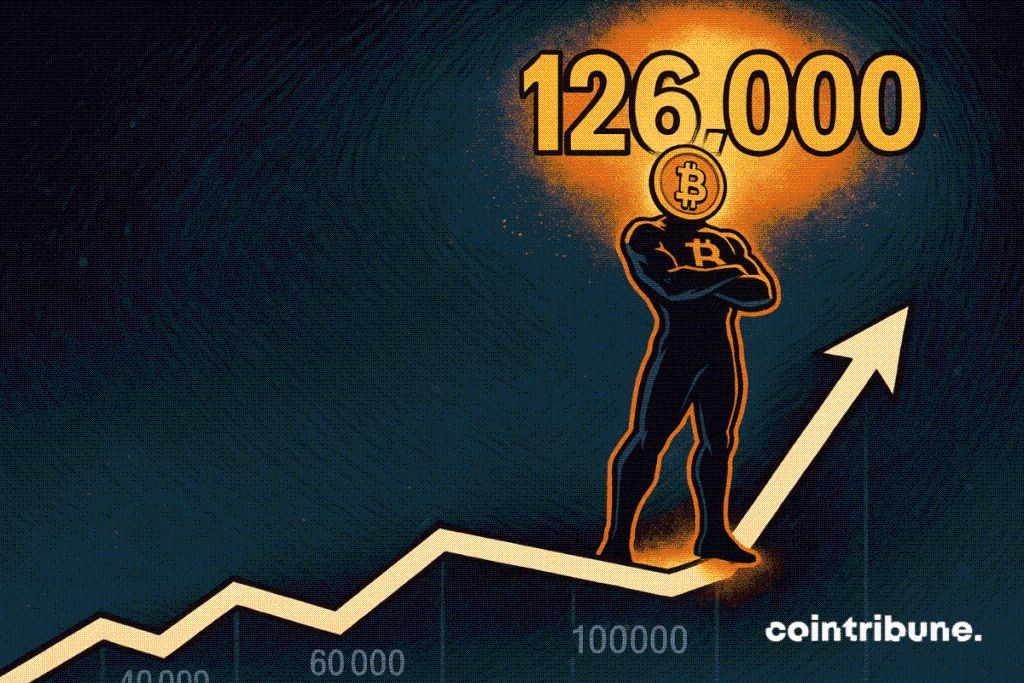Bitcoin Surpasses $126,000 Without Showing Signs of Overheating
Bitcoin has just crossed 126,000 dollars, but the market remains surprisingly quiet. This ascent without frenzy, rare in a universe where spectacular rises often precede violent drops, intrigues analysts. Unlike usual cycles, the apparent calm of the metrics fuels both confidence and curiosity. Should we see in this the beginnings of a new paradigm for the flagship crypto asset?

In brief
- Bitcoin has reached a new all-time high above $126,000, yet shows no signs of technical overheating.
- According to CryptoQuant, key indicators remain stable, with low volatility and a well-controlled upward trend.
- Analysts believe Bitcoin’s bull cycle could continue, as it has not yet entered its final post-halving phase.
- This movement is supported by an investment strategy known as the “debasement trade,” in which Bitcoin plays a central role against the depreciation of the U.S. dollar.
Momentum still under control according to analysts
This Monday October 7, bitcoin surpassed 126,000 dollars , reaching a historic high and strengthening the conviction of a bullish market.
However, unlike previous cycles, this progression is not accompanied by signs of overheating. Arab Chain, a contributor at CryptoQuant, states that “Despite this strong performance, technical indicators suggest the price is still moving within a stable range far from the overbought conditions that typically precede historical peaks”.
This observation might surprise, but it is based on a detailed reading of available technical signals.
Here are the main points highlighted in CryptoQuant’s analysis:
- The 30-day moving average of BTC is just below $116,000, indicating a gradual rise;
- Low volatility with a standard deviation of $4,540, reflecting price compression;
- Bitcoin’s growth ratio has been steadily increasing since May 2024;
- Positioning in the post-halving cycle: historically, peaks occur up to 600 days after halving, suggesting that bitcoin is still in an intermediate phase of its market cycle.
In summary, the technical data argue for a controlled progression, far from the emotional excesses often associated with market peaks. For Arab Chain, bitcoin is entering a phase of “balanced bullish momentum”, a rare state in the asset’s history, which could precede a new bullish impulse if liquidity continues to flow in.
The ETF Effect: Towards an Institutional Rush in the Fourth Quarter?
While on-chain indicators point to a controlled market, another dynamic stands out: that of American Bitcoin ETFs, accelerating rapidly.
For Matt Hougan, Chief Investment Officer at Bitwise, the fourth quarter could be record-breaking. He claims that “the stars are aligned for a very strong Q4 for flows — more than enough to push us to a new record”.
To support his analysis, Hougan recalls that ETFs have already recorded $22.5 billion in inflows over the first nine months of this year, and $3.5 billion were captured in just the first four days of the fourth quarter.
For him, this dynamic is explained by a mechanism often counterintuitive: “Although it’s a bit counterintuitive, higher prices often spur greater demand for Bitcoin ETFs”, as they attract the attention of media, retail investors, and institutions.
However, the real novelty comes from major wealth managers, increasingly opening their platforms to crypto ETFs . He notably cites an internal Morgan Stanley report published in October, which recommends its 16,000 advisors allocate up to 4% of portfolios to cryptos, as part of a multi-asset approach adapted to high-risk tolerance profiles.
This structural evolution, combined with what Hougan calls the “debasement trade”, the strategy of positioning on assets resistant to dollar depreciation, strengthens the appeal of crypto ETFs. While gold and bitcoin perform in this tight monetary context, advisors seek to integrate the best-performing assets into their clients’ annual balance sheets. “There’s only one way to do that: By buying gold and Bitcoin”, concludes Hougan.
As the end of the year approaches, attention will therefore focus on two fronts: the stability of the spot market and the ability of derivative products, such as ETFs, to channel the influx of institutional capital . If this dual dynamic is confirmed, the fourth quarter could not only break records but also firmly establish bitcoin as a reference asset.